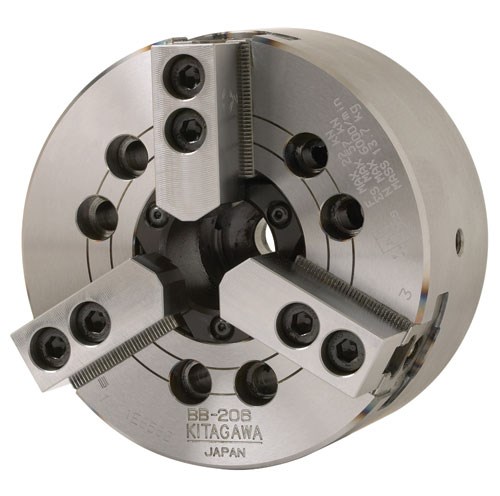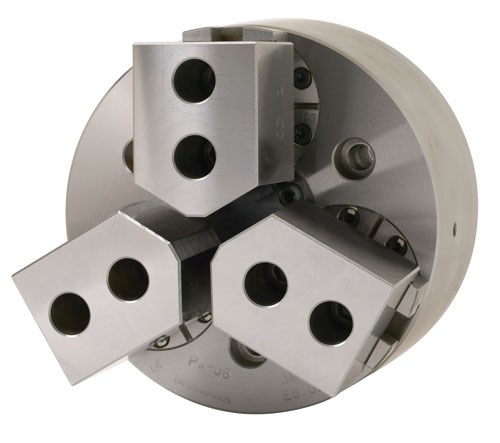Proper Workholding Selection
An in-depth look at the overall application is the best way to determine the most suitable workholding for a job. Experienced workholding engineers can play an important role in the selection process.
An efficient manufacturing process requires good machine selection, proper cutting tools and the right workholding. The first two areas typically receive substantial consideration, but workholding is often overlooked. This can be a costly mistake. The correct workholding selection can increase process stability, efficiency and the safety of a manufacturing process.
The proper selection of workholding involves more than simply accepting the chuck that came with the machine as the solution, but manufacturing managers on the shop floor often feel that they lack the in-house resources to determine the best non-standard alternatives. To incorporate the most efficient processes, though, a shop should invest the time to research the most appropriate solutions.
Many factors come into play when determining the best workholding option. Engineers will typically want to look at the material being cut, critical tolerance requirements, workpiece shape, workpiece dimensions, lot size and frequency of change-over. Along with these issues the workholding engineer will also look at the manufacturing process in detail to see how it can be optimized with workholding. In many instances altering the process in conjunction with good workholding can net large gains in throughput as well as part quality.
Stability for High Volume Work
High volume machining requires a different set of requirements than those used in a job shop. Running high volume parts requires a stable process to ensure consistently produced high quality parts over longer periods of time. This frequently leads to more specialized workholding solutions rather than the flexibility desired in the job shop.
To ensure the rigid holding of parts and satisfaction of part datums, pullback chucks are the frequent choice. Simply put, the chucks not only grip a diametric feature of the part, but then pull the part back against a rigid body part stop or locator. Pullback chucks are most commonly available in sealed configurations that aid the process in being less susceptible to varied maintenance schedules.
Depending on the machining operation and tolerance goals for the part, pullback chucks can be selected for either high positioning accuracy and length control in secondary machining or for higher gripping force, better suited to gripping forgings or castings for heavy roughing.
First, operation turning on a casting or forging can be greatly enhanced with a ball lock style chuck—a type of pullback chuck that is specifically designed to grip rough, unmachined surfaces such as castings and forgings. This chuck also is available in a compensating design. The compensating version uses some type of centering device mounted on the chuck face, such as a bull nose center or a collet. The jaws of the chuck will compensate around this center and are there to drive the part.
Kitagawa-NorthTech Inc. offers the PW family of chucks for this type of work. This chuck incorporates the ability to grip on draft angles, has radial jaw compensation, pullback and is sealed for minimal maintenance. The PW chuck also offers high grip force to allow heavy cutting for shorter cycle times.
If a secondary operation is needed (whether on a subspindle with chuck-to-chuck handoff or on a separate machine), using a sealed pullback chuck with high accuracy can drastically improve throughput and part quality. Kitagawa-NorthTech Inc. supplies the PU chuck for these types of secondary operations. This chuck offers great part repositioning and pullback to achieve highly accurate datum relationships. The chuck is also capable of high RPMs to reduce cycle time. Having a fully sealed design minimizes downtime because of maintenance. Both the PW and PU are capable of air seating and coolant thru so as to be very compatible with automation.
Quick Change
If the work is not high volume, the selection process is different. With the increasing use of multifunction machines, milling and turning in the same machine, chuck selection needs to focus on flexibility. The standard chuck that comes on the machine may work fine. However, if the lot sizes are very small, requiring frequent change-over, a quick jaw change chuck can be ideal. Kitagawa-Northtech Inc. has the QB series of quick jaw change chucks. These chucks allow very rapid jaw change to minimize downtime and increase efficiency. The QB chuck can be easily mounted in place of a standard chuck to keep the installation cost low. In some models of Kitagawa chucks, replacing only the master jaws allows conversion from a standard chuck into a quick jaw change type.
Collet chucks are another flexible alternative. Because collet chucks use a sliding sleeve to achieve grip force, they are less prone to the effects of centrifugal force and the resulting grip force loss. They are ideal in a bar feeding application to allow high speed machining of various types of barstock. The different collet types allow the gripping of round, square, hex and non-standard shaped work. Collet chucks are available as pullback and set-length style. A pullback collet chuck will do just as the name implies and pull the workpiece back as it clamps. Set-length collet chucks will grip the workpiece with near zero part movement.
Kitagawa-NorthTech Inc.’s QCRL series is an example of a set-length style collet chuck. These quick change chucks actuate the internal sleeve clamps down onto the collet without moving the workpiece. The QCRL is also a quick-change system that allows very short collet change-over time. In addition, this collet chuck can accept spring, multi-bore and master type collets. Using a low profile design allows more space for cutting tools to get near the chuck. This is especially important with multifunction machines when close work is required from a milling or tapping tool.
Big bore chucks come into play for maximizing the through spindle capacity of the machine tool. In some cases, more spindle bore capacity may be needed, but tool clearance issues prevent increasing the chuck size. This is often the case on multifunction machines. Kitagawa-NorthTech Inc. offers the BB200 series of chucks for this type of application. This chuck will give increased through-hole without going to a larger chuck size.
The Best Solution
Good workholding selection involves many factors that must be taken into account to achieve the desired results. Consulting with a workholding specialist early in the development of a new process or changing an existing one is important. Taking workholding into account as part of the manufacturing system can generate significant improvements in throughput, part quality and safety. Good workholding engineers can help to fully understand the details of the application and its workholding requirements. Only after fully understanding the application can the right solution be found.
Even the number of jaws in a chuck can play a critical role in the effectiveness of the workholding. The workpiece shape is the most important consideration for the number of jaws to use. Three-jaw chucks are the most common, as they are excellent at gripping round parts. For square work, a two-jaw chuck may be effective, but the best method is to use a four-jaw chuck that is a 2+2 design (each pair of jaws centers the part independently so that it is accurately centered in both directions). This design is very critical if the workpiece is not perfectly square.
The investment in a new, customized workholding solution is a relatively inexpensive strategy considering the additional profit it can bring to a shop. While a state-of-the-art chuck may amount to as much as 5 percent of the total cost of the turning center, productivity gains of 30 to 40 percent are not uncommon when the correct workholding solution is used.
Related Content
Starting Small with Automation
Quick-change workholding and flexible robotic automation started this small shop on the path to success.
Read MoreTool Path Improves Chip Management for Swiss-Type Lathes
This simple change to a Swiss-type turning machine’s tool path can dramatically improve its ability to manage chips.
Read MoreGerman Project Yields Three New Medical Machining Processes
Recent research has resulted in a new mix of high-speed turn whirl milling, polygon turning and rotational turning for manufacturing medical bone screws and out-of-round nails.
Read MoreThe Value of Swiss-Types Milling Rectangular Medical Parts
High-speed spindle technology was key to effective milling of small cardiac monitoring components complete on a CNC sliding-headstock machine platform instead of running them across two mills.
Read MoreRead Next
Selecting The Right Workholding Solution
These tips help solve turning, grinding and milling workholding problems, particularly for thin wall parts.
Read MoreWorkholding Collets And Factors That Affect Grip Force
The phenomenon of the staying power of the collet, in light of the rapidly changing technology in machine tool design, is attributed to the utility and the elegant simplicity of the device. The collet is a small but powerful component for the machine tool industry, incorporating all of the these features.
Read MoreDo You Have Single Points of Failure?
Plans need to be in place before a catastrophic event occurs.
Read More












.png;maxWidth=300;quality=90)











.png;maxWidth=970;quality=90)